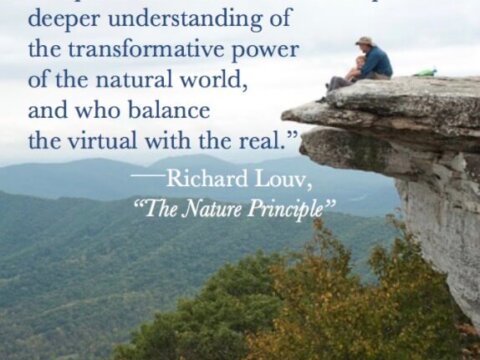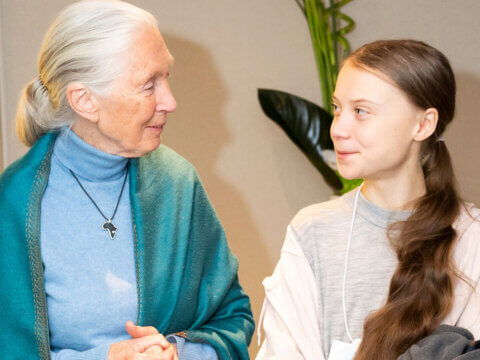Growing the Children and Nature Movement
Last year, I visited Ukiah, a mountain town nestled in the pines and fog. Ukiah is Spotted Owl Central, a town associated with the swirling controversy regarding logging, old growth and endangered species.
Educators and parents there reported that Ukiah kids aren’t going outside much anymore. A trend that touches even the most bucolic landscapes in our country, it raises a question: Is the spotted owl the leading environmental indicator species there, or is it another? I think it’s the latter. Taking nothing away from the spotted owl’s value, if kids aren’t going into nature, who will care about the owl in 10 or 15 years?
This theme is not new. What is new is growing evidence that something approaching a new children and nature movement is growing in America.
“We’ve reached a tipping point. A number of trends are now converging, from the sudden accumulation of electronic distractions to the growing fear of going outside,” says Kevin Coyle, vice president of the National Wildlife Federation, which is framing more of its long-range planning around the necessity to get kids directly involved with nature.
There are a number of hopeful signs.
Among them, the proliferation of nature-themed schools. The Milwaukee (Wis.) Journal-Sentinel reports the creation of a “unique preschool,” where “a 4-year-old can tell the difference between squirrel and rabbit tracks — even if he can’t yet read any of the writing on a map.” The preschool has “attracted attention across the country as increasing numbers of nature centers consider adding preschool programs as a way to create outdoor enthusiasts at a young age and address the growing demand for early childhood education.”
Also, The St. Paul (Minn.) Pioneer Press reported that a K-4 environmental magnet school will officially open in the 2007-08 school year, “but next year’s kindergartners will pilot the program and its partnership with a 320-acre ecological education center and habitat restoration preserve located across the street.”
Every school will be connected to an outdoor classroom; some will be on land adjacent to schools.
Such educators are bucking the test-centric trend in education; they point to a number of studies that link cognitive development and science scores directly to hands-on nature experience. In addition to creating future environmental consciousness, a children-and-nature movement could also add value to traditional conservation efforts.
A director of a land trust organization in New Hampshire tells me that setting aside land there is growing more difficult, as the public “has less and less patience with protecting land just for the sake of protecting it for future generations.” One strategy: pursue these causes — the conservation of land and connecting kids to nature — in tandem, and thereby make each more attractive to the public. For example, campaigns to protect natural habitats could be linked to the dedication of a small proportion of the acreage to the region’s children and families, with new nature centers on this land — ideally ones that offer a nature-oriented preschool and other educational offerings.
Something like this approach is occurring in San Diego. In an effort to create a San Diego Regional Canyonlands Park to protect the city’s unique web of urban canyons, Civic Solutions, the Sierra Club, and other organizations are touting the benefits of nature to child development.
At the same time, a countywide effort led by Anne Fegge of the San Diego Natural History Museum is creating a regional nature education network of educators and naturalists to “increase outdoor, environment-based educational programs based in canyons and other natural areas.” This two-for-one strategy could be a powerful new tool for conservationists and educators facing a population experiencing preservation-fatigue and discontent with public education.
While the children-and-nature movement is developing a national presence, regional and state campaigns will likely be the most dynamic engines.
State leaders are taking action. Connecticut Governor M. Jodi Rell recently announced the launch of a statewide “No Child Left Inside” campaign, which is designed to reintroduce children to the outdoors by raising public awareness of underused Connecticut state parks and forests.
Response to one of those programs, called The Great Park Pursuit, “has been overwhelming,” according to Gina McCarthy, commissioner of the Connecticut Department of Environmental Protection. “Within hours, hundreds of families had signed up.”
Other campaigns are more grass-roots. Led by the Cincinnati Nature Center, the Cincinnati No Child Left Inside campaign has marshaled the support of civic organizations, government and business.
Such efforts are reaching across cultures and professions to bring unlikely allies to the table. Developers, including Newland Communities, the nation’s largest privately owned residential developer, and AKT Development, Sacramento’s biggest developer, report their intent to find ways to design new communities that connect kids to nature. We’ll see how that plays out.
These are just a few clues to the potential depth of concern about the growing gap between children and nature. Certainly something is taking root out there. In coming years, we’ll see how deeply those roots reach.
-
Voices
CAMPING WHILE PARENTING: A Mother-Son Adventure
-
Feature
A common thread: Indigenous-led foundation weaves together activism and art, climate and community
-
Network News
Community Spotlight: Prescribe Outside
-
Voices
That’s nice, mija: Finding common language in nature connections
-
Richard Louv
"HUMMINGBIRD PARENTS": Seven Actions Parents Can Take To Reduce Risk And Still Get Their Kids Outside








Commentaries on the C&NN website are offered to share diverse points-of-view from the global children and nature movement and to encourage new thinking and debate. The views and opinions expressed are those of the author(s) and do not necessarily reflect the position of C&NN. C&NN does not officially endorse every statement, report or product mentioned.